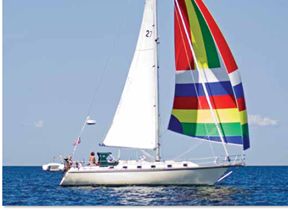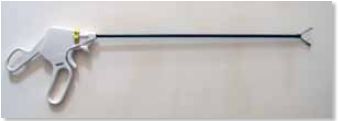
Photos courtesy of Fred BagleyPhotos courtesy of Gene Smith
288

339
Rob Ransone’s lament about difficult-to-clean cockpit drains (PS, May 2011) struck a chord with me as the drains on our Caliber 38, while generous in diameter, have a right-angle bend that clogs easily and is tough to clean.
One solution: Search out your local laparoscopic surgeon, the ones who for example remove gallbladders through tiny incisions using video cameras and long, skinny instruments. Most hospitals use plastic instruments for these operations, and they all must be discarded as they cannot be re-sterilized. These instruments make awesome tools for going into narrow, deep places, like cockpit drains with right angles or under your engine.
Ask your local surgeon (it helps if he or she is a sailor) to have the operating room team give you the tool instead of discarding it. Clean it in boiling water, and you have one of the most useful tools you will ever put on your boat.
Fred Bagley
Catamount, Caliber 38
Mendon, Vt.
Practical Sailor attempted to contact Teak Marine by email a few times, but the company has not yet responded. Have any other readers had good or bad experiences with this company that you’d like to share? Post them online or email them to practical-sailor@belvoirpubs.com.
In regard to the editorial in the December 2010 issue and the Mailport letter in the March 2011 issue about the “Great Anchor Debate”: I have to say that I am very biased in favor of CQR anchors as they took me around the world, anchoring a couple of thousand times, with only three dragging incidents, all of which were my fault for not letting out enough scope. We anchored on all types of bottoms, sand, hard mud, soft mud, rock, coral, weed, and who-knows-what because the water was 150 feet deep.
Nothing, repeat nothing, holds a boat in place on any bottom, and in any wind, better than a properly sized plow anchor and as much chain as you can let out. As much chain as you can let out means everything in the chain locker.
Laurie Pane
Dolphin Spirit, Mason 53
Australia and California
I just read in the June 2011 magazine that you are planning a test of epoxies. I am in the process of restoring a 1965 Pearson Commander 26-foot sailboat. I started using West Systems epoxy (www.westsystems.com) when I started this project and soon discovered that I am allergic to it. The inside of my arms broke out in a serious rash from using it.
I ended up switching to Raka Epoxies (www.raka.com), and the mix I use the most is the No. 127 resin with the No. 351 Non-blush hardener. So I am very curious how the Raka Epoxies compares in strength to the West Systems. Any chance you might include Raka in your testing?
Jerry Carpenter
Tampa Bay, Fla.
We’ll be sure to add Raka to the growing list of epoxy products we’ll be testing.

Photos courtesy of Fred BagleyPhotos courtesy of Gene Smith
288
I have been looking for a sticky pair of boat shoes for years. I have never seen any independent testing to see which boat shoes really work the best on a wet deck. Have you ever done a comparison of all the major shoes on the market? The best pair of boat shoes I have found was an old pair of Tevas but they were sandals and I want more of a shoe for protection.
Jon Kidder
Via email
Our last full-blown performance test of men’s athletic-style sailing shoes ran in the June 2007 issue. The Timberland Eurus Low II shoes topped the test field, and the Sperry Figawi2 was a recommended shoe. In December 2007, we ran a test update with a look at a pair of Teva shoes, the Helm2, which failed to beat out the Timberlands despite having excellent traction. The newest iteration of these shoes, the Teva Churn, has the same “spider rubber” traction and is a good-looking shoe. If you’d prefer a more traditional boat shoe, check out the February 2010 article on Columbia’s Sea Ray boat mocs; testers gave them two thumbs-up.
I’m sure others have pointed this out, but ex-professors can’t let such things pass. Reader Tom Nies (Mailport, June 2011) is correct in his “You Do the Math” letter: The area of a circle is usually expressed as Pi times Radius squared (Pi x R2), and varies as the square of the radius. But if you substitute the diameter measurement, which is twice the radius (R=D/2) in the equation, you get Area=Pi/4 x D2, so your original statement that the area varies as the square of the diameter was also correct. Now you see why ex-math professors don’t get invited to many parties.
Tom John
Pandora’s Boat, New Horizon 25
Hudson, Fla.
I’m reading with interest your June 2011 article about rope cleaning and rope hernias. There are two aspects to your testing I am concerned with: one is the machine settings you used, and two is the increased stability of older rope.
At Milwaukee Rigging (www.milwaukeerigging.com), we routinely tell our customers to clean their running rigging the same way they would launder a favorite sweater. This suggests using the gentle cycles on the washer—gentle agitation and slow spin—with a gentle detergent such as Woolite. I personally use this method with all my rope rigging and docklines on my O’Day 25.
In your follow-up article, please be sure to specify the settings of the washing machine in your testing. The “sweater settings” are excellent for rope rigging or docklines. Obviously no dryers, air dry is best for rope.
Dave Smith
Milwaukee Rigging
The full report on rope cleaning—including the settings used for the test—appears on pages 14-19 of this issue.
In 1975, I made all the running rigging for our C&C 25, including eye splices in double-braided polyester line from New England Ropes and wire-rope splices using New England Ropes double braid. I also made up two anchor lines and a set of docklines using three-strand nylon from West Marine.
After most uses, our lines are rinsed with fresh water. Once a year, all the lines are handwashed in laundry detergent and thoroughly rinsed before hanging them to dry. They are then stored in the boat for the winter.
The halyards I made in 1975 lasted 29 years in the New England sun, but at that point, really needed to be replaced. We still use our West Marine dock and anchor lines, which are still soft and supple.
We have had our share of cheap lines that have developed hockles and hernias. I firmly believe if owners choose and pay for good quality products and then spend the time to maintain them, there is no reason they should fail prematurely.
Jim Evans
C&C 25
Via www.practical-sailor.com
Has anyone raised issues concerning poor warranty support from ICP Solar Technologies (www.icpsolar.com) and their Pro-Kit solar panels? I have a defective model SE-1200 rigid 15W panel that they admitted is bad and covered by the warranty, but they have been unable to replace it. My initial complaint was sent to them on May 18, 2010. I get plenty of promises, but no results. The last communication I received from them was Aug. 12, 2010.
Joe Valinoti
Via email
Practical Sailor tried to contact ICP Solar regarding your problem, to no avail. We sent multiple emails and made several phone calls to customer service but never got a response. As of presstime, none of the emails nor phone numbers on the company’s website are operational. We would advise readers to steer clear of the ICP panels, unless you can find used ones with a known track record at a bargain price.
I wanted to thank you for bringing all the archives online at www.practical-sailor.com. I’ve long wished to peruse the archives with such ease. The added value of the online archives is immeasurable for me!
Patrick Schoonveld
Via email

Photos courtesy of Fred BagleyPhotos courtesy of Gene Smith
288
See the photo above: This is what happens when three or four owners get into a boat’s electrical system! How would anyone troubleshoot this mess at sea without causing a fire?
I stripped out a trash bag full of wiring and managed to save the original Catalina wiring harness and add a new branch for the VHF radio, depth sounder, GPS chartplotter, and stereo.
Note that the former “electrician” backed-up the piggyback splices with some green tape to keep them closed. I don’t like seeing those things on trailer wiring, let alone inside a boat.
It’s no wonder I found 11.4 volts at the bus bar with a 12.6-volt battery! The yellow trash bag twisties are a nice touch. Check out the open glass fuse dancing right next to the negative buss bar.
Gene Smith
www.genesmithstudio.com
Cherry Hill, N.J.
For the last five years, I have been a very happy owner of the Flip It Wheels made by Danard Marine. Due to our low tides in New England, I frequently needed to roll my 10-foot-6-inch, 120-pound inflatable over 100 yards, a good deal of it uphill. I have to haul through mud, small boulders, softball-sized mossy rocks, baseball-sized rocks, and ultimately gravel and sharp, broken shell. I have found the Flip It Wheels tires to be tough as nails.
Also, we almost always tow the inflatable, and have had no issues with leaving the wheels in the locked position. This enables us to roll up onto any beach we encounter, well above the high-tide mark. On long trips, or if rough weather is expected, the wheels just slide right out for on-board storage. Last year, through my own negligence, the tracks got damaged. When I needed replacement parts, the quick service was of the nature that Practical Sailors have come to appreciate and value over the years. In fact, Mr. Danard called me and included a set of inner tubes gratis.
Ed White
Caliente, Cal 35
Hull, Mass.
Practical Sailor’s test of dinghy wheels is underway, and we plan to include Danard’s product. Stay tuned for the report later this year.
A couple years ago, a girlfriend and I went bicycling around Europe (www.twochicksonbikes.blogspot.com). While travelling, we met a girl whose family had taken her out of school at age 12 to sail around the world for a year. She said it was the best thing that she had ever done. My boyfriend and I got to thinking: We too want to sail around the world one day!
We heard that boat makers often have to sail a sold boat to a buyer and that it’s possible to sign up as part of the delivery crew. We figured that would be a really good way to learn how to sail and travel. Do you by chance know anything about this?
Rachel Fields
Via email
Before you sign on for an ocean passage, it would be a good idea to get some basic sailing know-how. We suggest first checking into crewing with sailors in your area who may need crew or checking out sailing schools and community sailing programs. Beyond that, there are numerous crew-finder websites out there where you can sign up as volunteer crew. Two worth checking out are: www.digihitch.com and www.crewseekers.net.




































